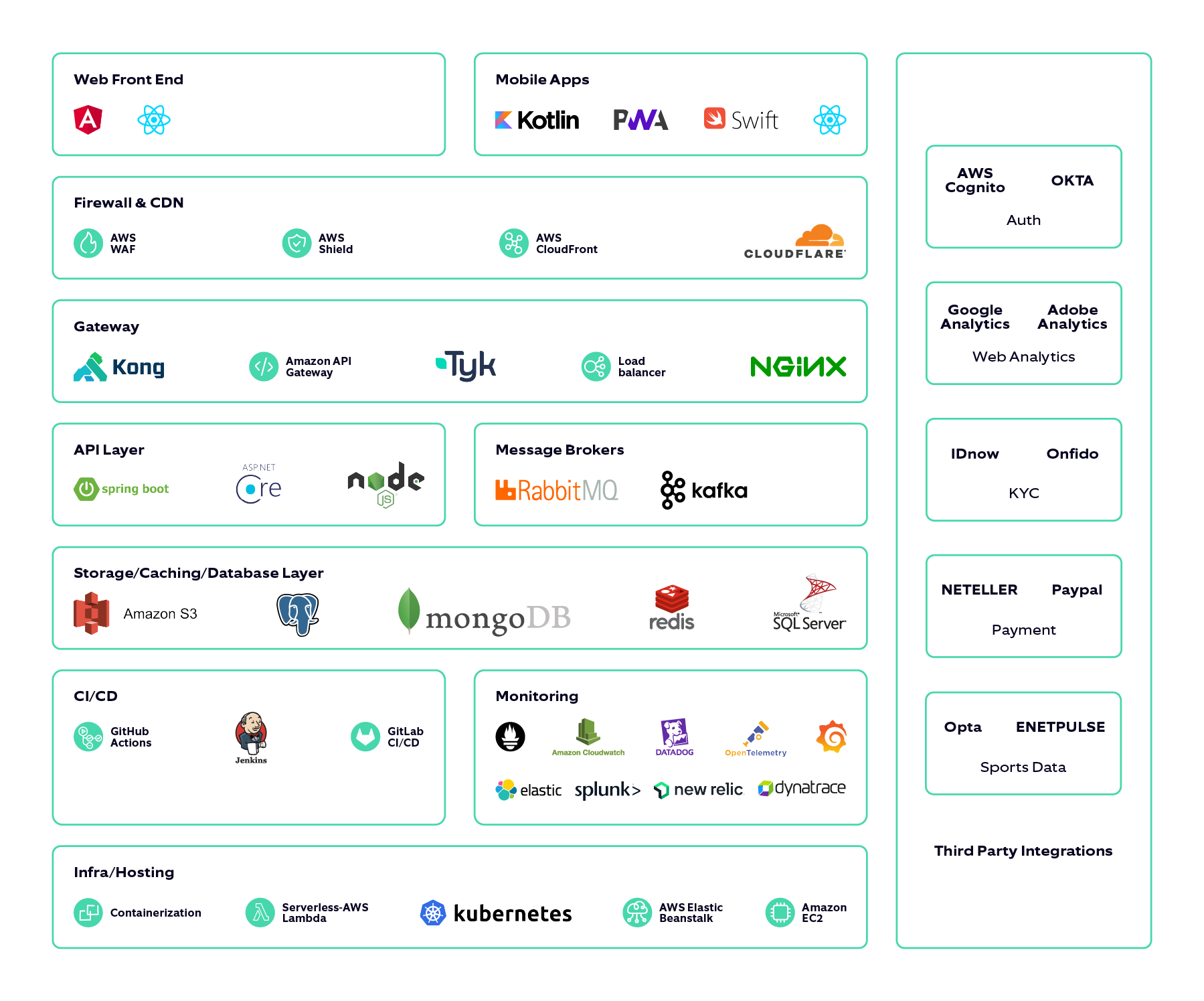In the first part, we discussed the high-level architecture of a Sportsbook, key components, important considerations, and best practices for building a scalable Sportsbook system. For more information, please refer to this link: [Link to the first part of the blog].
In this second part, we will assist you in making decisions about the technologies to be selected for each layer of a Sportsbook Software System.
Following is a snapshot of various technological options applicable to different layers in Sportsbook application architecture. Based on our experience, we have compiled the most effective solutions and explained the most important criteria for choosing the right option for each layer.

Fig: Various technological options applicable to different layers in Sportsbook application architecture
Note: We have used cloud services from AWS in this context, which can be substituted with equivalent services from any other preferred cloud vendor where the solution is deployed.
Frontend (User Experience Layer)
Technologies: React.js, Angular
Angular
When to choose: Need full framework for a large-scale Sportsbook with high modularity and built-in features
Best for:
- Enterprise-level apps with complex business logic
- Large-scale modular projects
- Long-term scalability needs
Key strengths:
- Comprehensive framework with built-in tools (e.g., RxJS, DI)
- Two-way data binding
- Strong TypeScript support
Key weaknesses:
- Steeper learning curve
- Performance overhead for smaller apps
- Verbose code
ReactJS
When to choose:
- Performant dynamic UI is high-priority
- Ready to live with a library which needs integration with additional libraries for various features like routing, API calls, state management, etc.
Best for:
- Real-time dynamic UI
- Performance-critical sportsbook features (e.g., live odds)
- Flexible integration with custom tech stacks
Key strengths:
- High performance with Virtual DOM
- Large ecosystem and strong community
- Component reusability
- Code reuse, if mobile app development is desired with React Native
Key weaknesses:
- Requires additional libraries for routing, state management, API calls, etc.
- Boilerplate code
Note: If micro-frontend architecture is desired, we may pick and choose both the technologies mentioned above based on their best use cases.
Backend (API Layer)
Technologies: ASP.NET Core, Java Spring Boot, Node.js
ASP.NET Core
When to choose:
- Priority is performance, concurrency, scalability and enterprise support
- Developers are well-versed with C#.NET
- Sample use cases: Real-time Odds/Markets management APIs, User management APIs, etc.
Java Spring boot
When to choose:
- Highly complex workflows and transaction heavy backend implementation is required
- Developers are well-versed with Java only
- Sample use cases: Bet settlement process, Payment integrations, etc.
Node.js
When to choose:
- Need lightweight APIs yet scalable with real time capabilities and event-driven implementation
- CPU intensive tasks implementation (e.g. complex calculations) is not the need
- Developers are well-versed with JavaScript
- Sample use cases: Real-time notifications for game updates, session tracking, user engagement through chat, etc.
* If microservices architecture is desired, we can select the most suitable technologies based on their best use cases, provided the necessary skill set is available.
Additionally, for microservices architecture, it’s essential to choose the right message broker. Two best options are RabbitMQ and Kafka. Here are some guidelines to help with the decision:
RabbitMQ
When to choose
- Need simple yet smart broker
- Need low latency, real-time interactions or just an async communication between microservices
- Point to point communication
- Not sure about future architecture evolution but need event-driven architecture at the moment
- Sample use cases: Transactional workflows, customer messaging, bet results & notifications, etc.
Best for:
- Real-time messaging
- Transactional systems
Key strengths:
- Low latency for real-time processing
- Advanced routing options (fanout, topic, header)
- Easier to set up and manage
- Extensive language and protocol support
Key weaknesses:
- Limited scalability compared to Kafka for very high loads
- Messages are deleted after consumption (short retention)
- No built-in support for message replay or event sourcing
Kafka
When to choose:
- Need to handle high-throughput live events streaming
- Need message retention or replay
- Need one-many pub-sub communication
- Need to handle real-time analytics or log aggregation from various sources
- Guaranteed ordering is a priority
- Focus is on data retention for analytics
- Sample Use cases: Live Odds or events streaming, Player activity logs & bet history processing, Real time analytics & fraud detection, etc.
Best for:
- High-throughput event streaming
- Analytics pipelines
- Event sourcing
Key strengths:
- Scalable distributed architecture with high throughput
- Durable message retention with replay capability
- Strong integration with big data tools
- Guarantees message ordering within partitions
Key weaknesses
- Higher latency for small, transactional messages
- Steeper learning curve due to complex setup and concepts
- Lacks advanced routing options like RabbitMQ
Data layer (Storage/Database/Cache)
Technologies: MS SQL Server, PostgreSQL, MongoDB, Object storage e.g. S3, Redis
While multiple options are available for caching, Redis is clearly the best choice due to its performance, flexibility, and rich feature set.
Please refer to this article to address any concerns about its BSD open-source license changes.
For database and object storage choices, here are some guidelines to follow:
PostgreSQL DB
When to choose:
- Free & open-source RDBMS for transactional and analytical workload
- Sample use cases: Betting transactions, Player Account Management, Betting trends reporting, Audit Logs for regulatory purposes
MS SQL Server
When to choose:
- Microsoft ecosystem, powerful in-memory processing, managed solution with less operational efforts and license cost is not an issue
- Sample use cases: All RDBMS use cases like the ones mentioned above for PostgreSQL
Mongo DB
When to choose:
- NoSQL to store unstructured or semi-structured data
- Sample use cases: Events, markets and other configurations, dynamic promotions & bonuses
Object Storage (S3 or any other cloud storage)
When to choose:
- Need to store unstructured data for a faster, scalable and easy URL-based access e.g. media files, static images, configuration files
- Sample use cases: Promotional banners, images, videos, live streaming metadata and media thumbnails, etc.
CI/CD & DevOps
CI/CD is crucial for keeping the application aligned with business needs and industry trends. DevOps tools can automate this entire process, helping with faster time to market. Some of these are mentioned in Fig 2 and here are details on when to choose each:
GitHub Actions
When to choose:
GitHub is already source code repository management solution
GitLab CI/CD
When to choose:
GitLab is already source code repository management solution
Jenkins
When to choose:
Need a free, open-source solution with highly customizable pipelines though fine with more set up efforts
For monitoring and observability:
Open-source
When to choose:
- Just starting and observability is not a focus yet
- Ready to spend extra efforts and operational cost
Some of the good options are as follows:
- ELK (Elasticsearch, Logstash, Kibana) is great open-source solution for logs management and visualization
- Prometheus + Grafana is a great combination for metrics management and visualization
- OpenTelemetry could additionally be implemented as an open-source and CNCF approved solution for distributed traceability & observability
COTS
When to choose:
- Availability of budget to procure licenses
- Need enterprise grade observability features
Some of the good options are as follows:
Splunk is a good industry-wide accepted logs management solution
NewRelic, Dynatrace, and Datadog are some of the best APMs and observability solutions available. New Relic does provide free tier with 100GB/month of data ingest (data sourced at the time of writing the article). Although all three have some of their USPs but if overall observability is the need, one can't go wrong with either of these. Amazon CloudWatch is a no brainer if solution is hosted on AWS cloud infra.
Infrastructure & hosting
Use cloud-native development and hosting whenever possible to ensure scalability and long-term cost efficiency.
Additionally, we prefer to use containerization for our applications, as it enables faster and more seamless deployments while eliminating environment-specific issues.
Here are some guidelines on when to choose which hosting option:
Containerization
When to choose:
Containerization is the first step towards a modernized efficient hosting. So, it is a must if aiming for scalable microservice architecture and hosting application on platforms like Kubernetes, ECS (Elastic Container Service) or Azure Container Apps/App Service, etc., leveraging CI/CD at it's best.
Kubernetes (AWS-EKS/Azure-AKS)
When to choose:
- Cloud native development with Microservices
- Choose Kubernetes over native EKS or AKS to be cloud-agnostic. This requires more operational efforts so ensure we have DevOps skillset equipped with Kubernetes management.
AWS Elastic Beanstalk/Azure App Service
When to choose:
Starting with Cloud migration and need a Lift & Shift (provided application framework is supported) Or want to avoid the complexity of Kubernetes through an all-rounder managed hosting service from cloud vendors.
Serverless (AWS Lambda/Azure Functions)
When to choose:
- Choose for small but infrequent and unpredictable workloads that are not resource-intensive e.g. batch processing of images
- Avoid in case of long-running tasks with lot of I/O
Virtual Machines (AWS-EC2/Azure VMs)
When to choose:
- Migrating to cloud and need a Lift & Shift with very minimal or no changes in software solutions
- Need isolation even at OS level for any security or compliance reasons
- Need to host a legacy stateful application
Additionally, use Infrastructure as Code (IaC) with tools like Terraform, Ansible, or AWS CloudFormation (or any equivalent cloud-specific alternative). However, our preferred approach is to remain cloud-agnostic, making Terraform or Ansible the recommended choices. If there is a concern about recent Terraform open source license change, OpenTofu is an alternative backed by Linux Foundation. It's forked from Terraform open source version.
Future of Sportsbook with AI
It’s interesting to see how AI is transforming iGaming. While traditional Sportsbook platforms rely on rule-based engines, manual risk management, and static user engagement, the future lies in AI powered intelligence.
Imagine a Sportsbook that can:
- Personalize odds and offers,
- Detect fraud & identity related issues in real-time using AI driven anomaly detection,
- Enhance customer experience with AI chatbots and predictive insights,
- Create a richer and more engaging experience with dynamic personalized content,
- And much more.
In the next part, we’ll look at how AI is reshaping the Sportsbook ecosystem and architecture, delivering unprecedented efficiency, security, and user engagement. Stay tuned for insights that redefine the game!
Develop your winning sportsbook solution. Connect with us now!
Sportsbook Platform Series: Quick OverviewGet a brief look at the four articles in this series: |





